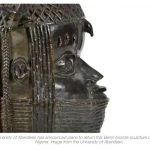Benin Bronzes: Plaques and Bronze Heads

The cultural heritage of civilizations often lies in the masterpieces they leave behind. The Benin Bronzes, particularly the Benin Plaques and Benin Bronze Heads, stand as remarkable testaments to the artistic and historical brilliance of the ancient Benin Kingdom. These exquisite artifacts carry a story of creativity, power, and tradition, connecting us to the rich tapestry of Africa’s past. In this blog, we will delve into the significance and historical context of Benin Bronzes, highlighting their importance and the ongoing efforts for repatriation and preservation.
The Magnificent Benin Bronzes
The term “Benin Bronzes” refers to a collection of bronze artifacts that originated from the Kingdom of Benin, located in present-day Nigeria. Although the name suggests they are made entirely of bronze, many pieces are actually brass, a copper-zinc alloy. The Enigmatic Benin Plaques
Among the most renowned pieces of Benin Bronzes are the Benin Plaques. These intricately crafted plaques served multiple purposes within the royal court. They adorned the walls of the Oba’s palace, depicting historical events, religious ceremonies, and scenes of courtly life. The plaques also symbolized the wealth and power of the kingdom, illustrating its significance in trade and diplomacy. Each plaque was meticulously cast using the lost-wax technique, showcasing the exceptional skill of Benin’s artisans.
The Captivating Benin Bronze Heads
Another captivating aspect of Benin Bronzes is the stunning collection of Benin Bronze Heads. These life-like sculptures were representations of the Obas (kings) and members of the royal family. The heads were typically created using the same lost-wax casting method, resulting in lifelike, expressive features that embody the spirit and authority of the rulers they represented. Each head served as a testament to the Oba’s lineage and reinforced the continuity of the Benin Kingdom’s dynastic power.
The Historical Context
The production of Benin Bronzes flourished during the height of the Benin Kingdom, between the 14th and 16th centuries. These masterpieces not only showcased artistic prowess but also served important cultural and political roles. Tragically, the Kingdom faced British invasion and the infamous Punitive Expedition in 1897. During this event, a significant number of Benin Bronzes were looted, and many of them found their way into the collections of museums and private collectors worldwide.
In recent times, there have been increasing calls for the repatriation of the Benin Bronzes to their country of origin. Nigeria and various international organizations argue for the return of these cultural treasures, believing that they belong to the people of Benin and hold immense historical and cultural value for the nation. Repatriation efforts highlight the importance of acknowledging the colonial history and the rightful ownership of these artifacts.
The Benin Bronzes, encompassing the Benin Plaque and Benin Bronze Heads, are more than just artistic masterpieces; they represent the cultural and historical identity of a thriving civilization. These artifacts offer us a glimpse into the grandeur of the Benin Kingdom, its sophisticated artistic traditions, and its powerful rulers. As the debate surrounding repatriation continues, it is crucial to recognize the significance of preserving and appreciating these treasures while also respecting the rightful claims of the country of origin. By doing so, we can honor the legacy of the ancient Benin Kingdom and celebrate the enduring beauty of the Benin Bronzes for generations to come.

